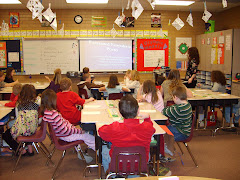As Tech Savvy teachers, we want to give our students the opportunity to use content-specific technology tools. We know that these technologies allow our studen
 ts to explore science in ways that are engaging and enjoyable.
ts to explore science in ways that are engaging and enjoyable. We used technology to teach about the reshaping of the Earth's surface, which is standard 2 in Utah's core curriculum for the 5th grade. Specifically, we wanted students to explore volcanoes, canyons, and mountain ranges after we had discussed the forces that create these landforms. Students were also given the task of describing the terrain of a new location, such as Nevada in our example. Google Earth is the technology tool students used to accomplish these tasks. The image to the right is an example of how students are able to see the topography of various landforms, in this case a volcano.
Google Earth enables students to view geographic locations throughout the world. We began by looking at the Mauna Loa volcano in Hawaii. Google Earth allows the students view the terrain of the actual volcano by using the 3D feature and by zooming in to the volcano. Students can move the focus around the terrain so they can explore the volcano in depth. As seen in the picture below, Google Earth also offers informational articles when this specific box is clicked. In this example, a Wikipedia article shows information about Mauna Loa.

 Next, students explored the geological features of the Grand Canyon. Students were able to see real photographs of the Grand Canyon alongside the topographical view. As the students explored the Google Earth images, we discussed the forces that created these landforms. Finally, students were instructed to explore a nonresidential area of Nevada and describe the terrain they see. Students also explained what forces shaped that terrain. An example of a student's view of Nevada is provided below.
Next, students explored the geological features of the Grand Canyon. Students were able to see real photographs of the Grand Canyon alongside the topographical view. As the students explored the Google Earth images, we discussed the forces that created these landforms. Finally, students were instructed to explore a nonresidential area of Nevada and describe the terrain they see. Students also explained what forces shaped that terrain. An example of a student's view of Nevada is provided below.
This technology of Google Earth allowed students to observe and analyze data in the form images. Because the images were three-dimensional, students were able to gain a deeper understanding of the content than they would have through a lecture with pictures. The following image of the Grand Canyon exemplifies the kind of images that students are able to manipulate to explore geological landforms. Investigating these landforms engages students in meaningful learning. This is one example of how tech savvy teachers use technology to enhance learning.
Google Earth enables students to view geographic locations throughout the world. We began by looking at the Mauna Loa volcano in Hawaii. Google Earth allows the students view the terrain of the actual volcano by using the 3D feature and by zooming in to the volcano. Students can move the focus around the terrain so they can explore the volcano in depth. As seen in the picture below, Google Earth also offers informational articles when this specific box is clicked. In this example, a Wikipedia article shows information about Mauna Loa.

 Next, students explored the geological features of the Grand Canyon. Students were able to see real photographs of the Grand Canyon alongside the topographical view. As the students explored the Google Earth images, we discussed the forces that created these landforms. Finally, students were instructed to explore a nonresidential area of Nevada and describe the terrain they see. Students also explained what forces shaped that terrain. An example of a student's view of Nevada is provided below.
Next, students explored the geological features of the Grand Canyon. Students were able to see real photographs of the Grand Canyon alongside the topographical view. As the students explored the Google Earth images, we discussed the forces that created these landforms. Finally, students were instructed to explore a nonresidential area of Nevada and describe the terrain they see. Students also explained what forces shaped that terrain. An example of a student's view of Nevada is provided below.
This technology of Google Earth allowed students to observe and analyze data in the form images. Because the images were three-dimensional, students were able to gain a deeper understanding of the content than they would have through a lecture with pictures. The following image of the Grand Canyon exemplifies the kind of images that students are able to manipulate to explore geological landforms. Investigating these landforms engages students in meaningful learning. This is one example of how tech savvy teachers use technology to enhance learning.


I think we have to make sure our names are somewhere on the blog post.
ReplyDeleteI think using Google Earth to explore different types of volcanoes was an excellent idea. I'm excited to actually be able to use this technology in my class someday.
ReplyDeleteThis is a great idea. I didn't realize how versatile Google Earth is. I am going to make a note of this for my future classroom.
ReplyDeleteThis is such a fun idea! I've never used Google Earth before, but I can tell it would be very interesting to use. I think kids would really love doing this activity.
ReplyDeleteVery well done. We will do another project using Google Earth later on where you will learn some more advanced techniques with the tool.
ReplyDeleteWow! I don't think I would have thought to use Google Earth as a technology but it really can be used as one! This was a great way to help the students to see visually what you are trying to tell them. It is an activity that I could see myself using in the future.
ReplyDelete